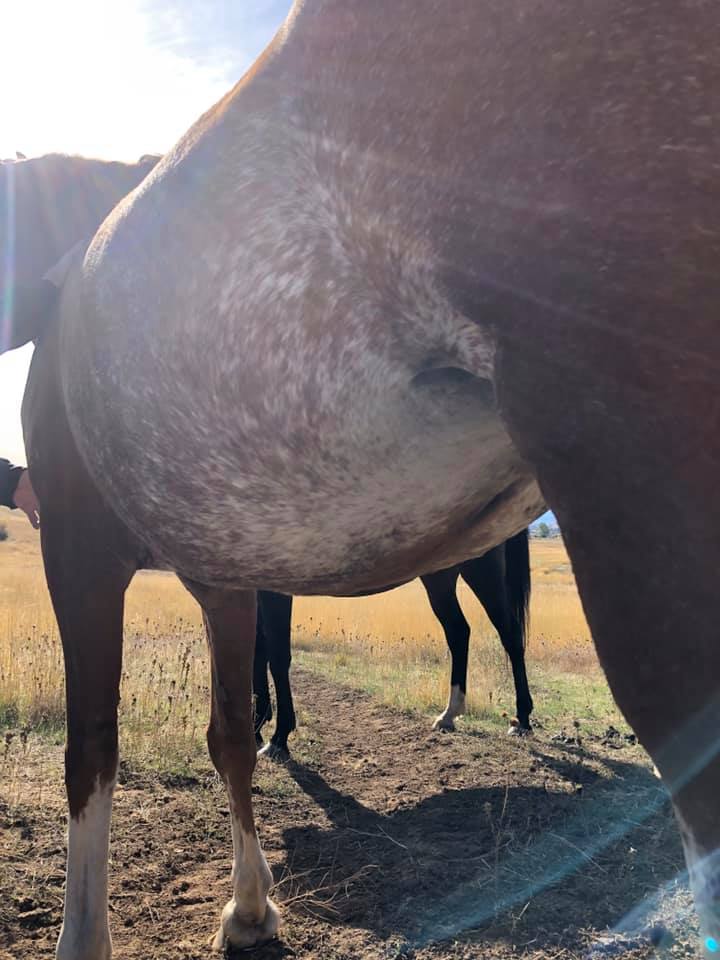Belly spots on DA Ginger Moon and her full sister DA Moon Dancer
Bev Davison posted these photos on Facebook. They feature the white belly spots of DA Ginger Moon (top) and her full sister DA Moon Sister (bottom). This follows an intense discussion on this blog about extreme white markings.


I am such a fan of belly spots and interesting white. Thanks to Bev for sharing these pictures!
I wonder, how much of that white is over pink skin, and not just heavy roan patterning over black skin? Would need summer and a wet horse to tell for sure!
Inquiring minds wish to know!
Although, white patterning doesn’t always require pink skin. We know Sabino causes roaning out, and it’s not unreasonable that other white spotting patterns would also cause some degree of progressive depigmentation in the hair.
This one filly I’m training is a very extensive tobiano, with the only pigment in her coat being her head, and part of her near-side belly and flank, oh, and a tiny black dot on her back. The rest of her coat is white. She had her first ever bath on Saturday, and I was fascinated to see that while she has a lot of the expected pink skin under the white, she also has a surprising amount of darker skin as well, such as dark “mottling” on her off-side haunch, despite the fact that the hair there is pure white. So there is still a lot about white markings/patterns that we don’t understand.
Yeah agree with Jeanne on the wetting test..
Looks definitely like intense roanning which is popping out quite often with the Pritzlaff bred horses (especially the ones with several Roga El Beda tail female IMO).
Also of interesting note : I always wondered about the physical description of Venus, which is so important in modern Egyptian bred horses. “Dirty grey” can bear lots of different meanings.
Lovely mares!
Here’s hoping that one or both could be bred to Bashir al-Dirri in the future!
He is also tail-female Basilisk, but through another granddaughter, *Bushra.
Venus was “shagra zefra” which means “dirty chestnut” not “dirty grey”. IMO it is a roan..
I hope so, too, Jenny!
Yes sorry “dirty chestnut” is an interesting description. It can be roan but also inhibited grey on a chestnut base coat both of them being very close from a phenotypic point of view. Trying to upload a picture of Qidam’s Sabbah, grey inhibited on a liver chestnut coat as an example.
https://static.blog4ever.com/2011/10/540382/big_photo_540382_11042524_2013100153091073.jpg
As an example, photo taken by her owner Catherine Roger
Wow! I have never before heard of inhibited grey. How does that work?
Always learning so much from this blog!
Co-sign, Jenny!
Not very common but there is a bunch of them in the El Dahma Halima (https://www.allbreedpedigree.com/el+dahma+halima) family from which we have quite a few in Europe.
We have no idea how it is working really but they all show a similar pattern.
Whatever the base coat it works only if the horse is carrying the grey gene.
We don’t know if it is working on both homozygous and heterozygous greys.
As a young horse until 6/7 years old, they look really solid, sometimes you can only see a couple of white hairs over the coat, just like you would on many solid horses.
From what I have observed so far until about 7-10 years old the horse will exhibit strange patterns who may look like unusual roaning.
Example : one of my mares, Meranti Daal Aba was showing a large spot (a little over the size of a human head) of white hairs mixed with the base coat.
Most of the time the greying seems to start around the bony areas : around the eyes, chanfrin, legs etc.
By the time they turn 15 years old the greying has expanded and they have the kind of mixed ‘mawari??” color you can see on the photo of Qidam’s Sabbah I linked.
As an aged horse they may look almost grey but they kinda keep an shade of the base coat that can be noticed trough the overall grey look.
It obviously works on every base coat as we have greys, bays and chestnuts showing this pattern.
Quite likely this is a recessive thing since not all of them are inheriting the inhibition. Though it is very hard to tell since many of them are still younger horses, so they just might look like roans (sometimes they are both rabicano + inhibited grey which is even more confusing ^^).
It may or may not be linked to the genes related to shades (sooty?). Since horses with darker shades (non fading black, liver chestnut and black bays) seems to grey out even slower that lighter shades – just like the standard greys.
A small article related to this color : https://colorgenetics.info/equine/gray-inhibitor-horses-possible-new-mutation
Interesting enough I have found several possible references to this coat, including one in LAB journals.
Oh, that’s fascinating, Amélie! I’ve seen photos of some odd greying in a PRE family as well, Comico IV and Comico VI, plus a Mangalarga Marchador, Favacho Único, where the onset of grey is very delayed. There are also photos of a Connemara stallion, Canal Laurinston, who greyed very late. They all of them seem to start on the bony areas first as well.